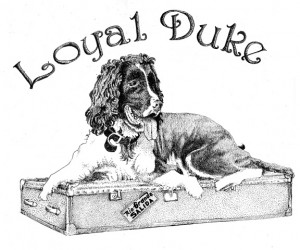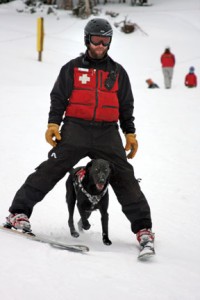By George Sibley
Barring strange accidents or chance, I’ve partnered with my last dog – mostly because my last dog was such a superior partner.
She was a Border Collie, Zoe; and Zoe was actually the only dog I’ve ever really partnered with, however unworthily. There were a couple other dogs in my life when I was a kid, but they were just family pets – bred for petdom. Border Collies aren’t bred to be pets, they are bred for intelligence and bred for work, and they more or less insist on – I would say, deserve – a partnership. And my partnership with Zoe was not really a “fulfilled” partnership because I didn’t really have any work for her to do that was worthy of her willingness.
Our daughter brought her into our lives. Zoe was a gift from her godfather, Steve Allen, a rancher over in the valley of the North Fork of the Gunnison who raises and trains Border Collies on the side. When Sarah went away to college three years later, my human partner and I inherited Zoe for what turned out to be the rest of her life (14 years total).
What Border Collies can do in a working situation is impressive. I’ve watched Steve work a dog with a bunch of sheep he kept on the ranch for that purpose. On a voice request from Steve – “command” isn’t the right word for the way this partnership works, the dog takes off on a dead run to circle around behind the sheep, then starts – well, intimidating, harassing the sheep into moving down the hill toward a human partner. Border Collies are not large dogs, but they can summon up a kind of “berserk” presence – eyes wild and penetrating, tongue out, appearing to be breathing fire. It conveys (to me as well as the sheep) a dim ancestral image of the great Pleistocene dire wolf just beyond the firelight.
So-called “Sheep Dog Trials” are held around the country. Meeker is probably closest – in which an almost fiendish set of tests are devised for teams of man and dog. After the dog moves the sheep down toward his or her human partner, there are really complex penning challenges, involving splitting the flock, then maybe singling out a pair with special colored collars and putting them somewhere else. The champion dogs are often older females at the Meeker trials. They’ve settled down to work, and have worked so long with their human partner that one could swear they are reading each other’s minds, and that may not be too far from the truth. Steve says the biggest challenge for the dog’s partner is not getting in a dog’s way with too much instruction.
We had nothing in our townie lives to provide any comparable work for Zoe. Not that moving stock is the only kind of work they find acceptable. Border Collies can be good baby-sitters, they are used in search and rescue work, they are good in hunting, they are great Frisbee-catchers, and they will keep your yard cat-free. They’ve also been recruited for therapy and assistance work. In fact, one Border Collie actually became a “hearing-ear dog” for a woman with severe hearing loss.
But the best tasks we could come up with for Zoe were little things, like Maryo sending her downstairs in the morning, if I was up early, to let me know it was coffee time. There was also a lot of ball-playing, and she invented tasks for herself, like patrolling the fence, tearing along it to keep cars moving along, but jumping up on it to welcome pedestrians. Neighbors on both sides of us eventually got Border Collies themselves after daily exchanges with Zoe at the fence.
What really got me about Zoe was her eyes. She would come sit on the floor in front of me and stare at me – not the berserk look she would have used on the sheep, but neither the look of adoration and submission we tend to associate with dogs. A look more like a question: “Hello? Are you there?” It was as though she had something to tell me that required me to be able to converse in her way. It got to me: “What, Zoe?” I would say. Sometimes she would actually lead me off, either to the door, or her food dish, or sometimes to some point where I could see no purpose at all. “What, Zoe?” I would ask, and she would just stand there looking at me, tail in a slow swish, waiting for me to get intuitively smart enough to understand.
Zoe made me think a lot about the “interspecies contract” whereby some of the wolves long ago decided to throw in with humans, to start collaborating with us rather than competing. Genetic analysis proves pretty conclusively that all dogs – even little Chihuahuas – are wolves in dog clothing. There’s a lot of speculation on when the wolves might have decided to switch rather than fight. Some speculations put the time at as much as 100,000 years ago, in East Asia. However, most guesses place it around the time, 10,000-30,000 years ago, when humans left off their hunter-gatherer lives and began to settle into agricultural and pastoral villages – farming where farming was possible, and herding the big herbivores where farming was marginal.
Both farming and herding can be viewed not just as “advances” in human culture, but as defensive measures brought about the population increases that accompanied the mellowing of the climate with the retreat of the last glacial epoch. Gatherers started planting seeds in centralized places they could protect as pressure grew from other gatherers. Hunters found themselves having to protect the herds they hunted from other human hunters as well as fending off the non-human predators.
The same kind of mellow-times population pressures grew among the non-human predators. A region can only stand so much new-pack creation among the wolves before they start killing each other at the territorial edges (like the humans do), just starving, or both.
It was in that time of transition that the contract between wolves and humans was presumably born, at the edge of the firelight. Those who say the leopard can’t change its spots have no answer for why wolves were able to transcend their instinct to run down, harass and kill the big herbivores, and perform the contradictory act of protecting them, even from their own kind who’d stayed beyond the firelight, rounding up and moving the former prey in consort with the two-leggeds who had formerly been their competitors. My feeling (mostly from having known Zoe) is that it had to have been an act of reasoning, the kind of thinking that we humans are supposed to have a sole proprietorship on, however little we seem to employ it.
They did it for the meal-ticket, of course, and the symbiotic relationship could probably be construed as species exploitation, a kind of slavery. Some people treat it that way, tyrannizing their dogs, turning dogs into killers of humans or other dogs, usually some reflection of something still “bestial” in humans, expression of which indulgent cultural environments still permit.
A new novel about this relationship – very engaging and really haunting – is “The Story of Edgar Sawtelle” by David Wroblewski, about three generations of dog breeders in Wisconsin who were trying to breed a strain of super-smart, empathetic dogs. The book includes a correspondence between the grandfather and another friendly but skeptical dog-breeder, who observed that the only way we’re going to get better dogs is to become better humans. Good food for thought.
ZOE
She forgave me, I hope,
For never finding the time to learn
To talk to her through my eyes.
And pontificating about her limits
For the lack of vocal cords,
Opposable thumbs, et cetera, and
All the while she’s standing there,
Her eloquent eyes exposing my limits.
That’s not all she forgave
I couldn’t match the unconditional
Commitment she brought to our life
Together, her bottomless capacity for
Forgiving our slights – forgetting
To let her in, to let her out, to feed her,
To meet her eye, to hear what she wanted
To give us through those great brown eyes.
She was probably still wild enough
To be useful – not crazy wild, just wild
Enough to see and hear and feel everything
You need to see and hear and feel around
Out on hikes she went ahead, she led
Even though she didn’t know where
We were going; she’d check back: I’ll lead you,
She’d say (her eyes), wherever you want to go.
She’s gone on now – eyes gone, hearing gone,
Joints gone, kidneys going, teeth going, gone.
It ceased to be a life when she couldn’t go
Ranging out ahead where she belonged,
Turning back to see if we were still coming,
To say, as I’m sure she would (me finally hearing
Her eyes) if we should meet again, some other pass:
“Come on, I’ll lead you, wherever you want to go.”
George Sibley was born in Western Pennsylvania, but was conceived in Colorado by Colorado natives, and thus considers himself to be a native Coloradan.

